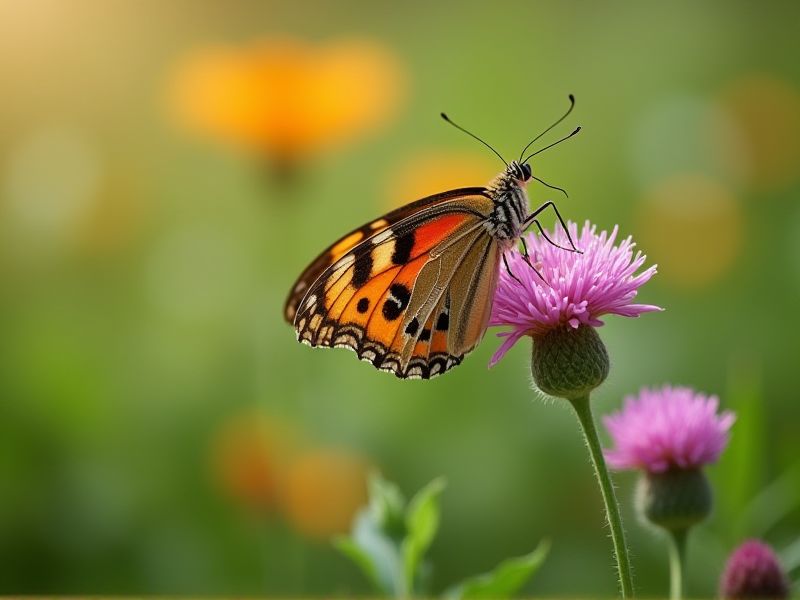
Butterfly plants, such as milkweed and coneflowers, are essential for creating vibrant ecosystems, attracting various butterfly species. These plants provide crucial nectar sources, helping to sustain adult butterflies and support their reproductive cycles. Incorporating butterfly-friendly flora into your garden not only promotes biodiversity but also encourages pollinator health by offering safe breeding locations. Native plants, like asters and goldenrods, are particularly effective, as they co-evolved with local butterfly populations, ensuring a harmonious coexistence. By selecting and nurturing these species, you cultivate a thriving habitat that benefits both butterflies and the overall environment.
List of some Butterfly plants that enhance habitats
- Butterfly Bush (Buddleja davidii)
- Milkweed (Asclepias spp.)
- Purple Coneflower (Echinacea purpurea)
- Black-Eyed Susan (Rudbeckia hirta)
- Joe-Pye Weed (Eutrochium purpureum)
- Lantana (Lantana camara)
- Zinnia (Zinnia elegans)
- Verbena (Verbena spp.)
- Aster (Symphyotrichum spp.)
- Bee Balm (Monarda didyma)
Important things about Butterfly plants that enhance habitats
Native Plant Selection
Selecting native butterfly plants can significantly enhance local habitats, attracting diverse butterfly species and supporting their life cycles. Plants like milkweed, coneflowers, and butterfly bush are essential for providing nectar and host sites for caterpillars. Incorporating these native species into your garden not only creates a vibrant ecosystem but also aids in the conservation of local flora and fauna. By offering a sustainable environment, you help promote biodiversity and ensure the survival of these vital pollinators.
Nectar Production
Butterfly plants, such as milkweed and coneflower, are vital for nectar production, providing essential food sources for butterflies. These plants not only attract various butterfly species but also contribute to the overall health of local ecosystems by supporting pollinator populations. By incorporating native nectar-rich flowers into your garden, you enhance habitats that sustain both butterflies and other beneficial insects. Consequently, fostering these plants can lead to increased biodiversity and a more vibrant garden landscape.
Host Plants For Caterpillars
Choosing the right host plants for caterpillars is essential for creating a thriving butterfly habitat in your garden. Milkweed, for example, is the primary food source for monarch caterpillars, providing both nutrition and a safe environment for their development. Other suitable host plants include parsley and dill for swallowtail caterpillars, which rely on these herbs for growth and survival. By incorporating a diverse range of native plants, you can attract various butterfly species, contributing to a resilient ecosystem.
Blooming Season Diversity
Butterfly plants, such as milkweed, coneflower, and butterfly bush, play a crucial role in enhancing habitats during blooming seasons. These plants not only provide essential nectar for butterflies, attracting various species, but also serve as host plants for caterpillars, facilitating their growth and development. By incorporating a variety of blooming plants in your garden, you can create a vibrant ecosystem that supports pollinators, improves biodiversity, and promotes a healthy environment. Consider planting native species, as they are best suited to local conditions and provide vital resources for butterflies and other beneficial insects.
Habitat Connectivity
Butterfly plants, such as milkweed and nectar-rich flowers, play a crucial role in enhancing habitat connectivity for various butterfly species. These plants provide essential food resources and breeding sites, facilitating the movement of butterflies between fragmented habitats. By incorporating diverse butterfly plants into your garden or landscape, you contribute to the local ecosystem's health, attracting both pollinators and beneficial insects. Creating corridors of these plants not only supports butterfly populations but also fosters biodiversity, ultimately enriching your environment.
Maintenance Requirements
Butterfly plants, such as milkweed and coneflowers, are crucial for creating vibrant habitats that attract and support butterfly populations. Regular maintenance includes pruning dead or damaged foliage to promote healthy growth and deadheading spent blooms to encourage continuous flowering, which provides essential nectar sources. Ensuring the soil is well-drained and enriched with organic matter not only helps sustain these plants but also enhances their ability to attract butterflies during their life cycles. By cultivating a diverse range of butterfly plants in your garden, you foster an ecosystem that supports pollinators and increases biodiversity in your outdoor space.
Pollinator-Friendly Practices
Incorporating butterfly plants into your garden significantly enhances pollinator-friendly habitats, fostering biodiversity. Varieties like the milkweed, coneflower, and lantana not only attract butterflies but also provide essential nectar sources and host sites for their larvae. By selecting native species, you can create a thriving ecosystem that supports local butterfly populations while promoting healthy soil and reducing the need for chemical fertilizers. Transforming your outdoor space into a butterfly haven contributes to the conservation of these crucial pollinators, ensuring their survival in an increasingly urbanized environment.
Soil Preferences
Butterfly plants thrive in well-drained, fertile soil rich in organic matter, crucial for fostering healthy growth. Native wildflowers like milkweed and asters not only attract butterflies but also enrich the soil ecosystem by encouraging beneficial microorganisms. Loamy soil, with its balanced texture and moisture retention, serves as an ideal medium for planting nectar-rich species that support various butterfly life stages. By choosing the right soil composition, you can create a vibrant garden that enhances butterfly habitats and promotes biodiversity.
Avoiding Pesticides
Butterfly plants, such as milkweed and coneflower, are essential for creating vibrant habitats that support diverse butterfly species. By opting for pesticide-free gardening, you not only protect these pollinators but also encourage a healthier ecosystem. Native plants attract butterflies at various life stages, providing nourishment and shelter, which is critical for their survival. Incorporating these plants into your garden can enhance its aesthetic appeal while promoting biodiversity and ecological balance.
Community Engagement
Butterfly plants, such as milkweed and asters, are essential for enhancing habitats that support both larval and adult butterfly populations. By incorporating these native flowering plants in your garden, you create a vibrant ecosystem that attracts not only butterflies but also beneficial pollinators like bees and hummingbirds. Each plant species plays a unique role in the life cycle of butterflies, providing crucial nourishment and breeding grounds. Engaging your community in planting these species can foster ecological awareness and promote biodiversity conservation in local environments.
